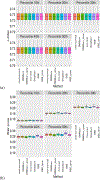Deep Neural Networks for Survival Analysis Using Pseudo Values
- PMID: 32167918
- PMCID: PMC8056290
- DOI: 10.1109/JBHI.2020.2980204
Deep Neural Networks for Survival Analysis Using Pseudo Values
Abstract
There has been increasing interest in modelling survival data using deep learning methods in medical research. Current approaches have focused on designing special cost functions to handle censored survival data. We propose a very different method with two simple steps. In the first step, we transform each subject's survival time into a series of jackknife pseudo conditional survival probabilities and then use these pseudo probabilities as a quantitative response variable in the deep neural network model. By using the pseudo values, we reduce a complex survival analysis to a standard regression problem, which greatly simplifies the neural network construction. Our two-step approach is simple, yet very flexible in making risk predictions for survival data, which is very appealing from the practice point of view. The source code is freely available at http://github.com/lilizhaoUM/DNNSurv.
Figures



Similar articles
-
Deep neural networks for predicting restricted mean survival times.Bioinformatics. 2021 Apr 5;36(24):5672-5677. doi: 10.1093/bioinformatics/btaa1082. Bioinformatics. 2021. PMID: 33399818 Free PMC article.
-
[Standard technical specifications for methacholine chloride (Methacholine) bronchial challenge test (2023)].Zhonghua Jie He He Hu Xi Za Zhi. 2024 Feb 12;47(2):101-119. doi: 10.3760/cma.j.cn112147-20231019-00247. Zhonghua Jie He He Hu Xi Za Zhi. 2024. PMID: 38309959 Chinese.
-
Unsupervised construction of computational graphs for gene expression data with explicit structural inductive biases.Bioinformatics. 2022 Feb 7;38(5):1320-1327. doi: 10.1093/bioinformatics/btab830. Bioinformatics. 2022. PMID: 34888618 Free PMC article.
-
Current directions in combining simulation-based macromolecular modeling approaches with deep learning.Expert Opin Drug Discov. 2021 Sep;16(9):1025-1044. doi: 10.1080/17460441.2021.1918097. Epub 2021 May 31. Expert Opin Drug Discov. 2021. PMID: 33993816 Review.
-
Application of deep learning methods in biological networks.Brief Bioinform. 2021 Mar 22;22(2):1902-1917. doi: 10.1093/bib/bbaa043. Brief Bioinform. 2021. PMID: 32363401 Review.
Cited by
-
Prediction and Risk Stratification of Cardiovascular Disease in Diabetic Kidney Disease Patients.Front Cardiovasc Med. 2022 Jun 24;9:923549. doi: 10.3389/fcvm.2022.923549. eCollection 2022. Front Cardiovasc Med. 2022. PMID: 35811691 Free PMC article.
-
Improved Survival Analyses Based on Characterized Time-Dependent Covariates to Predict Individual Chronic Kidney Disease Progression.Biomedicines. 2023 Jun 8;11(6):1664. doi: 10.3390/biomedicines11061664. Biomedicines. 2023. PMID: 37371759 Free PMC article.
-
Bayesian parametric models for survival prediction in medical applications.BMC Med Res Methodol. 2023 Oct 26;23(1):250. doi: 10.1186/s12874-023-02059-4. BMC Med Res Methodol. 2023. PMID: 37884857 Free PMC article.
-
Optimal Sparse Survival Trees.Proc Mach Learn Res. 2024 May;238:352-360. Proc Mach Learn Res. 2024. PMID: 39314758 Free PMC article.
-
Avoiding C-hacking when evaluating survival distribution predictions with discrimination measures.Bioinformatics. 2022 Sep 2;38(17):4178-4184. doi: 10.1093/bioinformatics/btac451. Bioinformatics. 2022. PMID: 35818973 Free PMC article.
References
-
- Martinsson E, “WTTE-RNN: Weibull time to event recurrent neural network,” Master’s thesis, University of Gothenburg, Sweden, 2016.
-
- Xinliang Zhu JY and Huang J, “Deep convolutional neural network for survival analysis with pathological images,” IEEE International Conference on Bioinformatics and Biomedicine (BIBM), 2016.
MeSH terms
Grants and funding
LinkOut - more resources
Full Text Sources
Other Literature Sources

